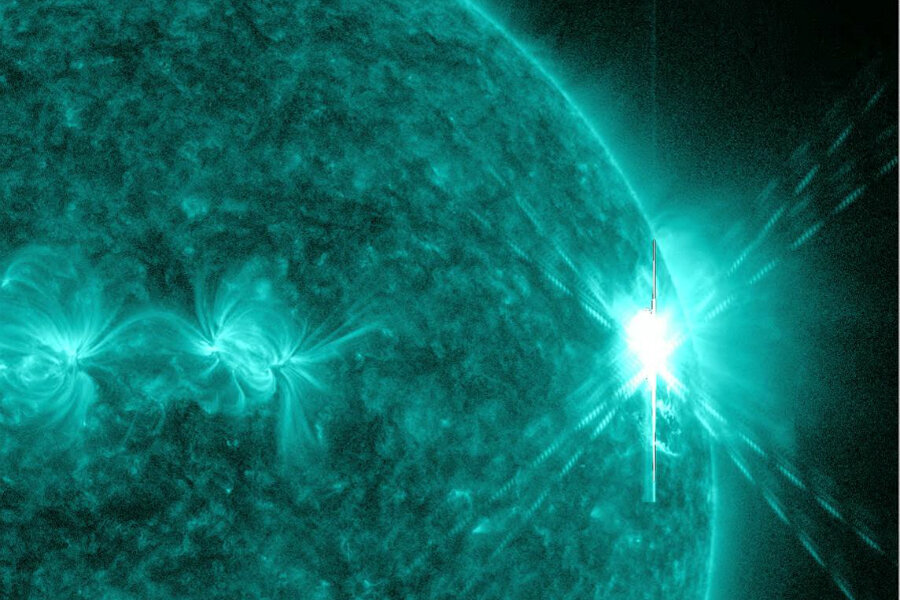In 1967, a solar storm almost triggered World War 3. What?
Loading...
Half a century ago, cold war tensions nearly came to a head over a couple of sunspots.
On May 23, 1967, the US Air Force was preparing its nuclear-armed aircraft for takeoff. The Soviet Union had jammed US surveillance radars, military officials believed, which was considered an act of war. But according to a new study published Tuesday in the journal Space Weather, scientists arrived just in time to defuse the situation: it was actually a solar storm, not a Soviet military operation, that jammed the radars.
"Had it not been for the fact that we had invested very early on in solar and geomagnetic storm observations and forecasting, the impact [of the storm] likely would have been much greater," Delores Knipp, a space physicist at the University of Colorado Boulder and the study's lead author, said in a statement. "This was a lesson learned in how important it is to be prepared."
Earlier that month, researchers had noticed a large group of magnetically charged sunspots on the solar surface. These cool, dark sunspots are known to launch bursts of solar radiation, called solar flares, as well as plasma eruptions called coronal mass ejections (CMEs).
On May 23, they recorded a solar flare so intense that it was visible by the naked eye. The flare gave off unprecedented levels of radio wave emissions. The same day, US military officials found that three of its Ballistic Missile Early Warning System radar sites appeared to be jammed. The Air Force prepared aircraft with nuclear weapons, ready to scramble in retaliation.
"This is a grave situation," Dr. Knipp said. "But here's where the story turns: Things were going horribly wrong, and then something goes commendably right."
Solar forecasters from the North American Aerospace Defense Command (NORAD) intervened in time to stop the launch. It was solar flares, not the Soviets, that jammed the radars. Research branches of the US military, it turns out, had been monitoring solar activity since the 1950s.
But it wouldn’t be the last time that an unusual cosmic event would trigger panic. When convention and science don’t offer satisfactory answers, we often turn to the fantastic as a plausibility.
Last month, an unidentified blip was spotted in the corner of an International Space Station video feed. But just as the object approached Earth’s atmosphere, the feed cut off, prompting rumors that NASA was covering up evidence of UFOs.
Astronomers say the blip was probably a small object floating nearby, rather than an large alien craft in the distance. Sometimes, science offers boring answers to fantastic questions, and that’s when people come up with their own theories to explain the mysterious.
“People are suspicious of any sort of power and hold-over information,” author Mark Fenster told the Monitor last month. “When the government reports on what they’ve found, any suspicious person will question what the government has released.”
And as information becomes increasingly accessible via the internet, so, too, does misinformation. Conspiracy theories and pseudoscience, which might otherwise be relegated to fringe publications, permeate Facebook and Twitter feeds. But connectivity can also provide quicker explanations – if NORAD had email in 1967, the "solar scare" probably would have been over before it began.
In July, NASA released an infrared photo that showed a massive dark spot enveloping the sun. The image prompted some initial fear – namely, that our star was dying – but astronomers quickly nipped panic in the bud. The spot was merely a coronal hole, a perfectly normal phenomenon relating to solar storms. Some believe that NASA deliberately released the strange images as a public relations move.
“Investigators working on NASA missions are under constant pressure to generate PR images for NASA public affairs folks to feed out to the public,” John Mariska, a research professor specializing in space weather at George Mason University, told the Monitor in July. “In my view, there is a tendency to overdo the hype. That being said, trying to inspire young people to consider a career in science is very important to the future of our country.”








